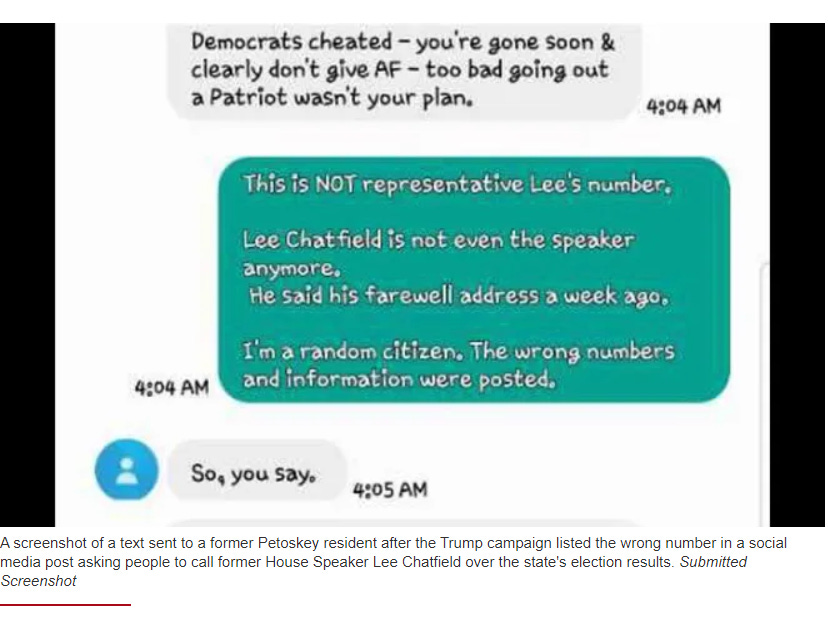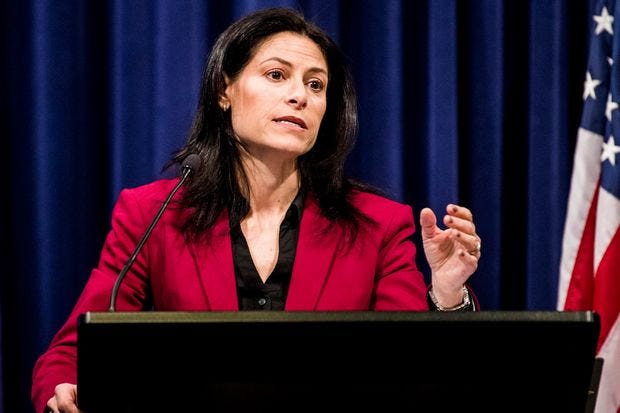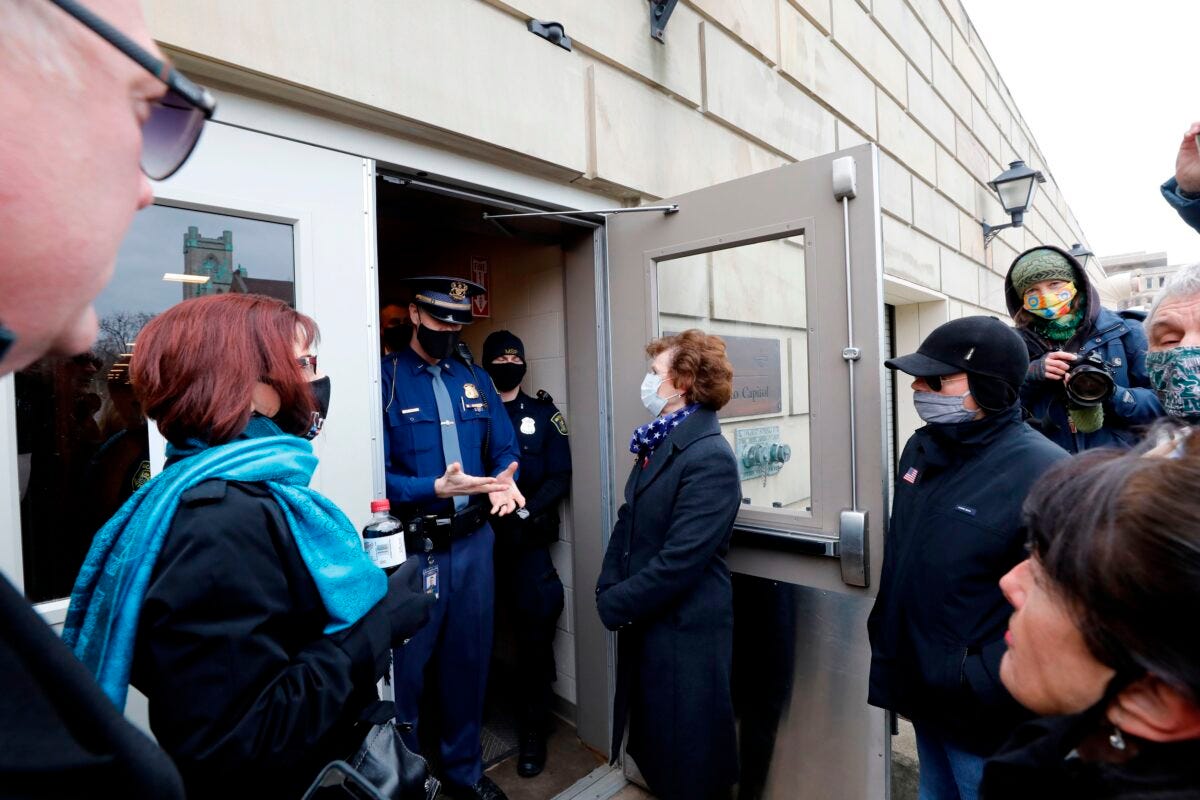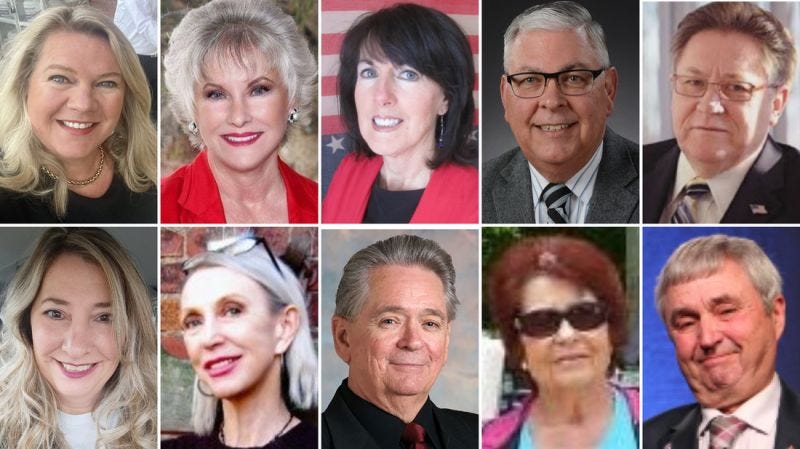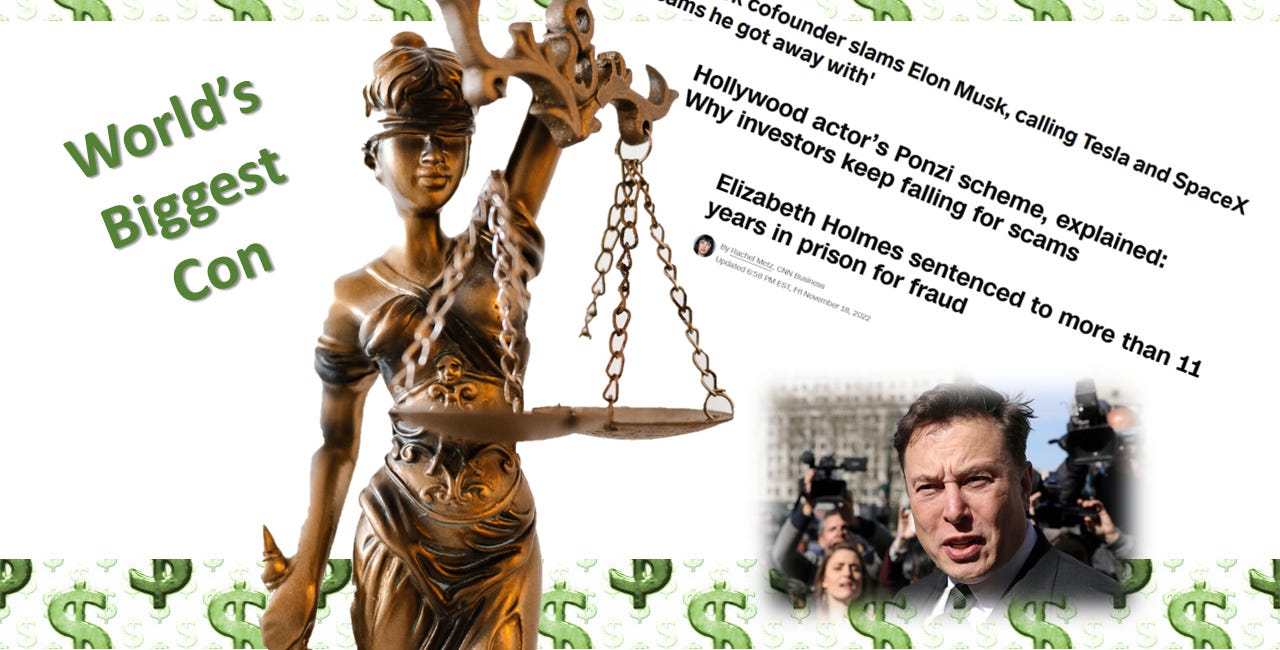Coup de Grâce
How One State’s Political Class Tried—and Failed—to Defraud the United States
Visit the Evidence Files Facebook and YouTube pages; Like, Follow, Subscribe or Share!
Find more about me on Instagram, Facebook, LinkedIn, or Mastodon. Or visit my EALS Global Foundation’s webpage page here.
Politics in the USA is currently in turmoil as the former President, Donald J. Trump, faces 70 criminal counts in a variety of courts all related to efforts to illegally gain or retain power or prestige. For many the latest indictment, levying just four charges, reflects his most pernicious behavior of all. Trump and a disturbingly large number of people from the political party he represents—the Republican Party—allegedly engaged in a criminal conspiracy toward the goal of keeping him in power. At each stage, plans failed—either as a result of a lack of legal justification or sheer incompetence—which culminated in a violent attempt to stop the lawful certification of his opponent’s electoral victory. Here is the story of one prong of a vast scheme to steal an American election.
A Quick Background
The United States President is decided by votes from a body known as the Electoral College. According to Article II, Section 1 of the US Constitution, state party conventions choose their electors under rules that differ from state to state. After their state’s general election, these electors meet within the geographic boundaries of the state to cast their votes for President, typically—though not always—in line with the popular vote result. Each state has a number of electors set by its population, which is why some states are considered “swing states.” Swing states are important because the vote there often determines the outcome of presidential elections. Upon each state’s Secretary of State or Governor certifying the vote of the state, the raft of electors submit their vote tallies to the President of the Senate (the sitting Vice President of the USA), the Archivist of the United States, and the judge of the district in which they meet. To win the presidential election, a candidate must receive at least 270 of the 538 total possible votes. The President of the Senate’s sole job is to open the certificates in the presence of both Houses of Congress and count the votes. The Constitution lays it out as follows:
The President of the Senate shall, in the Presence of the Senate and House of Representatives, open all the Certificates, and the Votes shall then be counted. The Person having the greatest Number of Votes shall be the President
Because of the upheaval in the 2020 election, Congress has since clarified that the law does not permit him or her to “determine, accept, reject, or otherwise adjudicate or resolve disputes over the proper certificate of ascertainment of appointment of electors, the validity of electors, or the votes of electors.”
Trump’s efforts to steal the 2020 election began with a movement ironically named “Stop the Steal” by his supporters. I wrote about this previously; this section sums it up:
It became apparent rather quickly that on the heels of a disastrous presidency, laden with numerous criminal convictions and ethics-related resignations or firings, that Donald Trump was destined to lose the 2020 election. Despite an over-estimate of Joe Biden’s lead in the two weeks prior to the election by most polls, even accounting for a large error margin it was clear Biden would win by millions. And, well, he did. As the then-President Trump’s team awaited his imminent loss, disgraced attorney Rudy Giuliani purportedly stated, “just say we won.” Not long after, many politicians or would-be politicians began repeating the mantra, either to remain in lockstep with what they viewed as their voting base, or in an effort to win their own elections (or bemoan their losses, like in the case of Kari Lake). If it is true that in an alcoholic stupor Giuliani did in fact say such a thing, that might have been the moment of conception for what became known as the Big Lie. The fraud caused harm much greater than mere financial gain—several people died in or as a result of the January 6th riot, some thousands of people earned themselves a criminal record and jail time there and elsewhere, and many Americans now view political division as among the most serious problems in society (this in a country where children of certain ages are more likely to die by gunfire than anything else).
I stated there that Rudy Giuliani initiated the Big Lie before the election was even called in finality. It turns out that the plan to simply declare victory—irrespective of the vote count—was proposed even before election day. Mother Jones obtained an audio recording of Steve Bannon—former Trump campaign manager and convicted criminal—telling a group of his associates that Trump already planned to attempt to steal the election predicated on this Big Lie. Bannon said, “What Trump’s gonna do is just declare victory. Right? He’s gonna declare victory. But that doesn’t mean he’s a winner. He’s just gonna say he’s a winner.” No doubt, Bannon, Giuliani, and the rest of their associates knew Trump was sure to lose. After all, Trump has not actually won any federal election to date, if you measure it by the popular vote.
Source: Statista
Trump had been hinting for some time that he had no intention of relinquishing power, whether or not he lost the election. In July 2020, he told Chris Wallace “No, I’m not going to just say yes. I’m not going to say no, and I didn’t last time either.” This was his answer to whether he would accept the election results. Later, when asked directly whether he would commit to a peaceful transfer of power, Trump said “We’re going to have to see what happens.” Seemingly based on Bannon’s advice to just “say he’s a winner,” Trump told several people he would declare victory if it “looks like he’s ‘ahead’.” At the same time when in front of the media, Trump denied that he would make a premature declaration, but complained about the fact that it takes longer than election day to determine the results. Nevertheless, before the final vote came in on election night, Trump publicly announced “We were getting ready to win this election. Frankly, we did win this election.”
Conspiracy in Michigan
In November of 2022, US Attorney General Merrick Garland appointed an independent prosecutor to investigate Trump’s very public criminal efforts. This prosecutor became known as the Special Counsel. The Special Counsel’s DC indictment explicitly states that Trump knew he had lost the election, but persisted in making false statements about it because they were “integral to his criminal plans to defeat the federal government function, obstruct the certification, and interfere with others’ right to vote and have their votes counted.” The indictment charges the following: 1) conspiracy to defraud the USA, 2) conspiracy to obstruct an official proceeding, 3) obstruction of and attempt to obstruct an official proceeding, and 4) conspiracy against rights. These counts include a scheme to certify fraudulent electors in seven of the swing states, wherein party members in those states would attempt to pass forged electoral certifications to either overtake the lawful ones, or to disrupt the proceedings by sowing chaos and confusion. This article examines the conspiracy in one state, Michigan, where the Attorney General of the State, Dana Nessel, has charged 16 Republican party members with numerous crimes for attempting to perpetrate it. Each defendant has been charged with:
One count of Conspiracy to Commit Forgery, a 14-year felony,
Two counts of Forgery, a 14-year felony,
One count of Conspiracy to Commit Uttering and Publishing, a 14-year felony,
One count of Uttering and Publishing, a 14-year felony,
One count of Conspiracy to Commit Election Law Forgery, a 5-year felony, and,
Two counts of Election Law Forgery, a 5-year felony.
The Michigan defendants’ plan probably developed based on a series of memos written by Trump campaign lawyer, and alleged co-conspirator, Kenneth Chesebro. (update: Chesebro is now an officially indicted co-conspirator, but in a case filed in Fulton County, Georgia, not the DC case discussed herein.) Chesebro told the Talking Points Memo (TPM), “There was good reason to argue that under Article II, that Biden had not legitimately won the electoral votes. I’m not saying that Trump deserved to win in each state, I’m saying it was legitimate to argue under Article II that there was a problem.” Yet, in an email exchange with another lawyer and co-conspirator, soon-to-be-disbarred John Eastman, Chesebro laid out a scheme to convince then-Vice President Mike Pence to abscond from his duties of certifying the election in a way that seemed to disregard the existence of any “fraud problem.” He explained his purpose quite concisely—the goal was simply to prevent the lawful election of Joe Biden and Kamala Harris:
[I]t doesn’t seem fanciful to think that Trump and Pence would end up winning the vote after some legislatures appoint electors, or else that there might be a negotiated solution in which the Senate elects Pence Vice President and Trump agrees to drop his bid to be elected in the House, so that Biden and Harris are defeated, even though Trump isn’t reelected.
That email, originally sent to Rudy Giuliani and later forwarded to Eastman, was dated the day before the electoral count, which was scheduled for December 14. By that date, most of the electoral disputes had already been adjudicated and dismissed by various courts. Chesebro was encouraging conduct directly in contrast to the Electoral Count Act. That Act essentially prohibits people from submitting “alternate slates” of electors once a state certifies its count. He all but admitted to his criminal role in orchestrating the false elector scheme, telling TPM “If you don’t know for sure the final result by December 14, it can be prudent to have multiple electors cast the ballot.” None of the states at issue allowed under their laws to create an alternate slate of electors. In other words, Chesebro’s plan focused less on the concern for fraud and more on the timing of the outcome and interest in sowing major upheaval. Both of the latter goals aligned with Bannon and Giuliani advising to “just say we won.”
The Department of Justice showed a keen interest in Chesebro, issuing a subpoena to him to testify in a grand jury back in March 2023. To date, the public does not know what he may have said in that session. Chesebro also testified before the January 6 Select Committee. Curiously, when asked by that Committee whether he communicated with the Michigan fake elector schemers, he pled the 5th against self-incrimination. (“Pleading the 5th” is a colloquial way of saying you do not want to answer a question because the answer will incriminate you. The 5th Amendment of the US Constitution prohibits compelling a person “in any criminal case to be a witness against himself”). The Committee then asked Chesebro if he worked with anyone to prepare the documents that would later be used in states Trump lost. Put simply, did Chesebro work with anyone to create the fake elector documents? Chesebro answered again by pleading the 5th. The same routine persisted thereafter. While pleading against self-incrimination does not prove criminality, in non-criminal hearings it certainly suggests it (in the civil realm, this is referred to as an “adverse inference”). The Jan 6 Committee was not a criminal hearing.
Chesebro also invoked attorney-client privilege when responding to questions about his interactions with other members of the Trump campaign. Attorney-client privilege protects communications between an attorney and client that relate to the litigation even, for example, if a client admits to his attorney that he is guilty. Chesebro will likely not be able to invoke that privilege in a grand jury proceeding (though he can continue to plead the 5th). Prosecutors could force him to testify to his communications under the crime-fraud exception because attorney-client privilege cannot be used to conceal evidence of a crime involving the attorney himself. As Chesebro has been named a “co-conspirator,” the prosecutor is essentially saying that communication between Chesebro and the Trump campaign were part of the crime itself and therefore not protected. In any case, the evidence is quite compelling that Chesebro was one of the principle instigators and facilitators of the fake elector scheme. A former Trump campaign staffer said as much.
With the plan in place prior to the election, Trump associates kicked it into motion immediately following the loss. Two days after the election, for example, Donald Trump Jr. forwarded a message to White House Chief of Staff Mark Meadows that stated:
State Assemblies can step in and vote to put forward the electoral slate[,] Republicans control Pennsylvania, Wisconsin, Michigan, North Carolina, etc. we get Trump electors… we either have a vote WE control and WE win OR it gets kicked to Congress 6 January . . .
Trump Jr.’s message was clear. The plan was for them to control the outcome in the swing states that would decide the election.
Vince Haley, Deputy Assistant to Trump for Policy, Strategy and Speechwriting, asserted that State legislators “have the constitutional right to substitute their judgment for a certified majority of their constituents” and that radio hosts and others should “apply pressure to the weak kneed legislators in those states.” Johnny McEntee, the President’s Personnel Director replied, “Let’s find the contact info for all these people now.” Haley later sent McEntee contact numbers of GOP legislators in six states, including two in Michigan, and proposed that the President “invite them down for a WH meeting.” On November 12, Trump asked Michigan Republican Congressman Tim Walberg to check “how supportive they could be in regards to pushing back on election irregularities and potential fraud.”
On November 20, Trump did in fact “invite them” as Haley suggested. Trump met in the Oval Office with the two Michigan contacts sent by Haley—the Republican Speaker of the Michigan House of Representatives and the Republican Majority Leader of the Michigan Senate. Giuliani, who phoned into the meeting, engaged in a long monologue proclaiming all kinds of fraud in Michigan’s vote. The two Michigan representatives replied that Trump lost Michigan because he had “underperformed with certain voter[s]” in the state, not that he lost due to fraud. They added that they would not do anything to violate Michigan law. Trump and Giuliani did not seem pleased. After the meeting, someone from the Trump campaign tweeted out the personal cell phone numbers of both representatives stating that people should “demand vote on decertification.” The tweeted numbers received thousands of calls and texts (one number apparently was incorrect leading to some random person receiving a barrage of calls and texts instead).
Source: The Detroit News
On November 23, Michigan’s Governor signed a certificate notifying the federal government that the state’s electors had chosen Joe Biden for President. On November 25, attorneys Sidney Powell, Scott Hagerstrom, and Gregory J. Rohl filed a federal lawsuit on behalf of several of the Republican electors and others against Michigan’s governor. The lawsuit proffered three claims: violations of the Elections and Electors Clauses; the Fourteenth Amendment Equal Protection Clause; and the Fourteenth Amendment Due Process Clause. For relief, Plaintiffs asked the court to decertify the election results and order Defendants "to transmit certified election results that state that President Donald Trump is the winner of the election.” Four days later, Trump tried on November 29 to convince the Michigan Attorney General he had not lost, but the Attorney General advised him (again) that they had found no evidence of fraud. During and after that time, Trump continued saying publicly that a “vote dump” had occurred in the state leading to nearly 150,000 fraudulent votes cast for his opponent—Trump lost the state by 154,188 votes. Two days later on December 1, then-US Attorney General William Barr told Trump, “Did anyone point out to you—did all the people complaining about it point out to you, you actually did better in Detroit than you did last time? I mean, there’s no indication of fraud in Detroit.” The very next day Trump repeated claims about the “vote dump” publicly.
On December 2, Giuliani attended the Michigan House Oversight Committee hearing. Before it began, he conducted an online presentation in which he stated, “nothing wrong with putting pressure on your state legislators.” That “briefing” was conducted with Michigan’s State GOP Chairwoman Laura Cox. At the hearing after his briefing, Giuliani told House members to “have the courage to say that certification that was done by your state is a complete phony.” He continued that legislators could do what they want, including changing the certification the day before the electors’ election day (December 14). This was false. In fact, the law expressly forbade it. Meanwhile, on the same day as the Michigan hearing, a Trump campaign supervisor texted to staffers instructing them “to explain the process for legislative redress and tell [Michigan Republican legislators] how to send representative[s] to th[e] electoral college.”
Three days after Trump’s failed attempt to persuade the Michigan Attorney General there was fraud, Giuliani sent a text message to the Michigan House Speaker asking for help with “reversing the ascertainment of the legitimate Biden electors.” A couple days later on December 7, Giuliani sent another text message, this time to the Michigan Senate Majority Leader:
So I need you to pass a joint resolution from the Michigan legislature that states that, * the election is in dispute, * there's an ongoing investigation by the Legislature, and the Electors sent by Governor Whitmer are not the official Electors of the State of Michigan.
Around the same time Giuliani sent that text, the federal court in Michigan [mentioned above] issued an opinion denying all of Sydney Powell’s Plaintiffs’ claims in their election-centered suit, writing that the lawsuit was:
stunning in its scope and breathtaking in its reach as it sought to disenfranchise the votes of the more than 5.5 million Michigan citizens who ... participat[ed] in the 2020 General Election.
All the attorneys involved in filing that suit, Sydney Powell et. al., were eventually sanctioned for unethical conduct for filing a frivolous suit that provided no legal or evidentiary foundation. In the evening on the day of the court’s ruling, the Michigan House Speaker and Michigan Senate Majority Leader issued a public statement reiterating that they had “not yet been made aware of any information that would change the outcome of the election in Michigan and as legislative leaders, we will follow the law.”
On December 8, a former State legislator in Louisiana sent a text to Mark Meadows—Trump’s Chief of Staff—that Trump electors from several states including Michigan “meet next Monday at their state capitols[,] [c]all themselves to order, elect officers, and cast their votes for the President... Then they certify their votes and transmit that certificate to Washington.” Meadows replied, “We are.” Three days later, the US Supreme Court rejected election challenges in several states, including Michigan. Justin Clark, one of the Trump campaign lawyers, told the Jan 6 Committee that he said to his colleagues “unless we have litigation pending like in these States, like I don’t think [asserting alternate electors] is appropriate or, you know, this isn’t the right thing to do.” In other words, Clark knew that without the flimsy “cover” of pending election lawsuits, they could provide zero justification for attempting to certify alternative electors. The Supreme Court’s ruling destroyed what little remained of that “cover.”
In response to what the current Attorney General of Michigan, Dana Nessel, has labelled the Trump team’s “call to action,” sixteen Republican party members in the state moved forward with engaging in a scheme to submit their fraudulent elector slates, irrespective of the law or facts. On December 14th, the day the electoral votes had to be submitted, the Michigan defendants (i.e., the fake electors) met covertly in the basement of the Michigan Republican Party headquarters to sign the false electoral certificates. There, they signed their names to multiple documents stating they were the “duly elected and qualified electors for President and Vice President of the United States of America for the State of Michigan.” They were of course not “duly elected” or “qualified.” Within the documents themselves was an additional attestation that was clearly false. One page stated that the fake electors had “convened and organized in the State Capitol, in the City of Lansing, Michigan, and at 2:00 p.m. … performed the duties enjoined upon us.” These defendants did not meet in the Capitol as they had been banned from entering because they lacked any authority to do so. Thus, signing an official document asserting that they had “convened and organized in the State Capitol” was both false and a violation of several laws. And finally, the largest deception present in their documents was that Trump had won the vote count in the state. The defendants, or someone on their behalf, then submitted the falsified documents to the National Archives. Senator Ron Johnson and Representative Mike Kelly (both Republicans) sent their staffers to work together to try to get the falsified documents to Vice President Pence. The Michigan documents never made it, though some other states’ fake certifications did.
AG Nessel said of the conspiracy:
[T]here was no legal authority for the false electors to purport to act as ‘duly elected presidential electors’ and execute the false electoral documents. Every serious challenge to the election had been denied, dismissed, or otherwise rejected by the time the false electors convened. There was no legitimate legal avenue or plausible use of such a document or an alternative slate of electors. There was only the desperate effort of these defendants, who we have charged with deliberately attempting to interfere with and overturn our free and fair election process, and along with it, the will of millions of Michigan voters. That the effort failed and democracy prevailed does not erase the crimes of those who enacted the false electors plot.
Note that these defendants are presumed innocent until proven guilty in a court or they confess via plea to their crimes.
Michigan Attorney General Dana Nessel; Source: Wall Street Journal
Since their arrests, some of these defendants have claimed that they “did not know” they were breaking the law by signing the fake certificates. Court filings, however, illustrate that these conspirators had a pretty good idea that they were engaged in unlawful conduct. For example, when they had their “covert” meeting, they prohibited anyone from bringing in recording equipment. Furthermore, Laura Cox, the former leader of Michigan’s Republican Party, described why she did not join the scheme:
[Someone from Trump’s campaign] told me that the Michigan Republican electors were planning to meet in the Capitol and hide overnight so that they could fulfill the role of casting their vote in—per law in the Michigan chambers. And I told him in no uncertain terms that that was insane and inappropriate. [Emphasis mine]
Cox could tell something clearly illegal was afoot. And make no mistake about her general dishonesty about the election process. On the night of the state vote count, for example, she falsely tweeted “Republican poll challengers blocked from entering the TCF Center in Detroit! This is egregious!” The reality was that Republicans already had more people in the center than the law allowed. Nevertheless, even for someone predisposed to lie about activities related to the election, Cox was not depraved—or foolish—enough to join the fake electors scheme.
In addition, the manual by which the defendants were trained explicitly says:
The Michigan State Supreme Court has held that the statutory duties of the Boards of County Canvassers are ministerial and clerical… These enumerated powers described by the Michigan Supreme Court exclude the power to examine the manner in which city or township clerks administer elections, investigate reports of election malfeasance, or in any way ‘go behind’ the Statements of Votes or poll books delivered to the Board for the purpose of determining frauds in election. [Emphasis in original]
Aaron Van Langevelde, a member of the state board of canvassers (which is the term there for its electors) that makes the vote tally official, publicly proclaimed “We must not attempt to exercise power we simply don’t have.” Thus, the defendants’ ignorance argument is unavailing. Indeed, at the meeting to officially certify the election, held three days after the December election day, Van Langevelde commenced by saying “The board’s duty today is very clear. We have a duty to certify this election.”
Finally, the fake electors signed a document with a fabrication sitting right in the middle of it: “convened and organized in the State Capitol, in the City of Lansing, Michigan, and at 2:00 p.m. . . . performed the duties enjoined upon us.” They absolutely knew this was false since police prohibited them from entering the State Capitol and they thus engaged in their crimes in the Michigan Republican Party headquarters instead. Even if they had a right to commence their vote—which they did not—state law explicitly states it must be conducted in the Capitol, which is probably why they made sure to include this provision in their fake documents.
Michigan electors denied entry to the Capitol; source: Epoch Times
Some of the conspirators directly admitted their participation, such as Meshawn Maddock who publicly said “We fought to seat the electors.” This defendant seems to be relying on the Trump defense of this all being some kind of political persecution, which does not seem to be a wise strategy. Moreover, this is mere rhetoric as there is no provision under Michigan law to “fight” to “seat” anything. The Michigan Election Law Act 116 § 168.42 says very plainly:
The candidates for electors of president and vice-president who shall be considered elected are those whose names have been certified to the secretary of state by that political party receiving the greatest number of votes for those offices at the next November election. [Emphasis mine]
In making her admission of guilt, Maddock also implicated the Trump campaign, stating “Um, the Trump campaign asked us to do that.” Mari-Ann Henry, another of the defendants, said through her lawyer that she has “been falsely accused.” The evidence strongly suggests otherwise.
In another bizarre twist, two additional Republicans, former attorney general candidate Matt DePerno and GOP ex-state Representative Daire Rendon, were charged just two weeks after the fake electors in a somewhat related scheme. Rendon led the failed attempt of the fake electors to enter the State Capitol in 2020, though he is not a signor on the falsified documents. He and DePerno now face four criminal charges for essentially stealing voting machines, among other crimes. DePerno had previously pursued legal action against the state over the election results. An investigative committee concluded his assertions were “demonstrably false and based on misleading information and illogical conclusions.” It appears that because that didn’t work, he elevated his conduct into the criminal realm. Seven others have been named in this scheme, and charges against at least some of them are expected soon. Reporting on the story does not yet indicate what exactly these defendants and their co-conspirators planned to do with the machines.
Both the fake elector and voting machine stealing cases remain pending.
While all the evidence pertaining to these cases has yet to make it to the public eye, it seems that many of these defendants face a high chance of conviction accompanied by some serious prison time. In a hearing on August 4, the presiding court described the amount of evidence against defendants Henry and Maddock as “voluminous.” Statements of innocence by two of the defendants or their attorneys are hardly persuasive. Although it is possible all the defendants will stick to their guns and take their cases to trial, the odds are better that at least some will accept a plea and testify against their co-conspirators. After all, eight of the defendants are 70 or older, and are probably not willing to take the chance of dying in prison for their role in this hairbrained scheme.
The elector scheme defendants are named as:
Kathy Berden, 70, of Snover
William (Hank) Choate, 72, of Cement City
Amy Facchinello, 55, of Grand Blanc
Clifford Frost, 75, of Warren
Stanley Grot, 71, of Shelby Township
John Haggard, 82, of Charlevoix
Mari-Ann Henry, 65, of Brighton
Timothy King, 56, of Ypsilanti
Michele Lundgren, 73, of Detroit
Meshawn Maddock, 55, of Milford
James Renner, 76, of Lansing
Mayra Rodriguez, 64, of Grosse Pointe Farms
Rose Rook, 81, of Paw Paw
Marian Sheridan, 69, of West Bloomfield
Ken Thompson, 68, of Orleans
Kent Vanderwood, 69, of Wyoming
Some of the accused fake electors; Source: CNN
Note that information above was sourced, in some cases, from the DC Federal Indictment.
***
I am a Certified Forensic Computer Examiner, Certified Crime Analyst, Certified Fraud Examiner, and Certified Financial Crimes Investigator with a Juris Doctor and a Master’s degree in history. I spent 10 years working in the New York State Division of Criminal Justice as Senior Analyst and Investigator. Today, I teach Cybersecurity, Ethical Hacking, and Digital Forensics at Softwarica College of IT and E-Commerce in Nepal. In addition, I offer training on Financial Crime Prevention and Investigation. I am also Vice President of Digi Technology in Nepal, for which I have also created its sister company in the USA, Digi Technology America, LLC. We provide technology solutions for businesses or individuals, including cybersecurity, all across the globe. I was a firefighter before I joined law enforcement and now I currently run a non-profit that uses mobile applications and other technologies to create Early Alert Systems for natural disasters for people living in remote or poor areas.
For another story about a serial criminal, click below.





